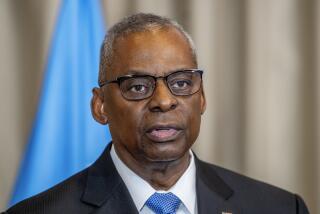Joint Chiefs Chairman Mullen says more troops likely needed in Afghanistan
- Share via
WASHINGTON — Facing increasingly skeptical congressional Democrats, the nation’s top uniformed officer said Tuesday that the Obama administration’s strategy to counter Afghanistan militants probably means that more troops will be needed there.
The comments are likely to sharpen an intensifying national debate over the future of the mission in Afghanistan that could force President Obama to decide between military leaders pushing for more firepower and his political base wary of a quagmire. Growing numbers of Democrats, including top congressional leaders, have expressed doubts about increasing the number of combat troops.
Navy Adm. Michael G. Mullen, the chairman of the Joint Chiefs of Staff, said Tuesday that he had not received a formal request for additional trainers and combat troops. But Mullen said that, based on the strategy outlined by Army Gen. Stanley A. McChrystal, the top allied commander in Afghanistan, a larger force is likely to be needed.
“He is alarmed by the insurgency, and he is in a position where he needs to retake the initiative from the insurgents, who have grabbed it over the last three years,” Mullen said in testimony before the Senate Armed Services Committee.
Sen. Carl Levin (D-Mich.), the committee chairman, greeted the prospect of additional combat forces coolly. Levin has proposed sending more U.S. trainers, but believes the Pentagon should hold off sending combat troops until there are more Afghan forces in the field.
“Providing the resources needed for the Afghan army and Afghan police to become self-sufficient would demonstrate our commitment to the success of a mission that is in our national security interest, while avoiding the risks associated with a larger U.S. footprint,” Levin said.
Even as Democrats continued to signal skepticism, Republicans on the committee said they supported additional troops and warned the White House against delaying a decision on whether to send additional reinforcements.
Sen. John McCain (R-Ariz.), the leading Republican on the committee, said that each day of delay “in implementing this strategy and increasing the number of troops” further endangers American soldiers and Marines. Mullen appeared before the Senate committee for a hearing on his nomination for a second term as Joint Chiefs chairman. He said no decision had been made to send forces other than the additional 21,000 Obama has already approved.
Mullen avoided discussing specifics of how many additional troops would be needed, saying only that more “resources” would be needed to execute the administration’s strategy.
“A properly resourced counterinsurgency probably means more forces,” Mullen said.
He said the additional forces might be needed in part because Afghanistan had not received the troops and equipment it needed in years past.
“We very badly under-resourced Afghanistan for the better part of four or five years,” Mullen said.
Mullen’s comments went somewhat further than Defense Secretary Robert M. Gates’ remarks this month, in which he said he would be receptive to a request for additional forces.
Pentagon Press Secretary Geoff Morrell said Gates’ views on the subject are continuing to evolve.
“He is undecided on this issue and is still debating it himself, still analyzing it himself, and has yet to come to a final resolution,” Morrell said.
Much of the discussion Tuesday focused on how to speed up the training of Afghan security forces.
Morrell said that Gates and Levin met last week to discuss the senator’s preference for sending additional training units rather than combat forces.
But Gates does not see a clear line between U.S. forces with a training mission and those with a combat role, Morrell added.
“As we learned in Iraq, our best training is done not in some sterile environment behind the wire but rather out amongst the population, operating shoulder to shoulder with our Iraqi or Afghan counterparts,” Morrell said.
At the hearing, Mullen told Levin that to meet the current goal of 235,000 Afghan security forces, the U.S. and its allies would need to field 2,000 to 4,000 more trainers than the 6,500 now in the country.
That number would probably increase if McChrystal, as expected, seeks an even larger Afghan police and army contingent.
Mullen said key strategies from the war in Iraq would be applied to Afghanistan.
“Not every lesson from Iraq will apply, but the big ones will,” he said.
--
More to Read
Sign up for Essential California
The most important California stories and recommendations in your inbox every morning.
You may occasionally receive promotional content from the Los Angeles Times.










